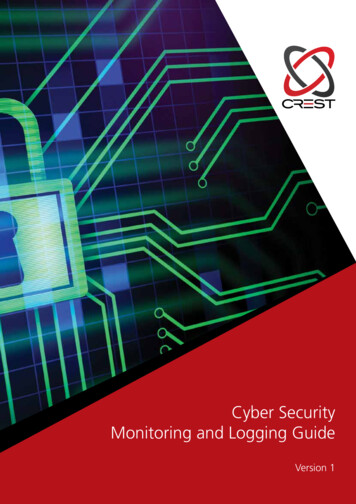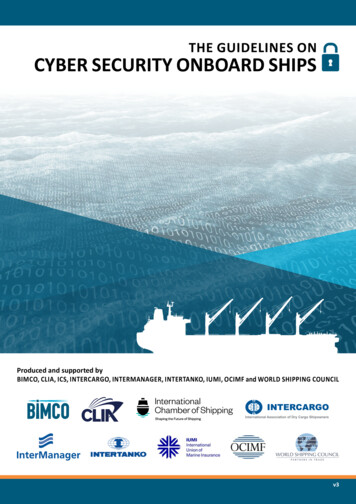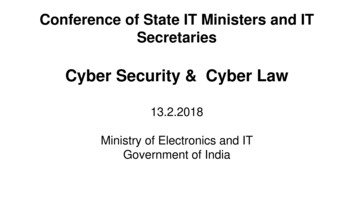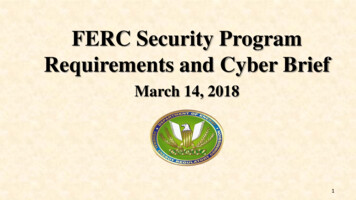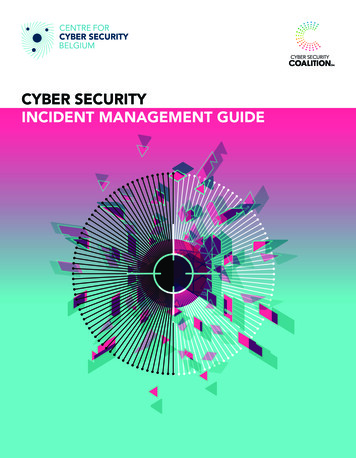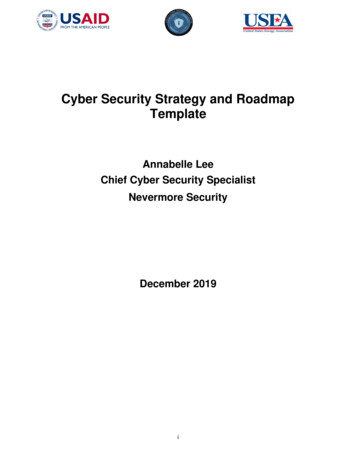
Transcription
Cyber Security Strategy and RoadmapTemplateAnnabelle LeeChief Cyber Security SpecialistNevermore SecurityDecember 2019i
TABLE OF CONTENTS1CYBER SECURITY STRATEGY OVERVIEW . 1-11.1Governance Framework . 1-11.2Utility Strategy . 1-11.2.1 Policies and Regulations . 1-21.2.2 Enterprise Vision, Mission, and Strategic Objectives . 1-21.2.3 Cyber Security Vision, Mission, and Strategic Objectives . 1-31.2.4 Cyber Security Roadmap . 1-41.3Cyber Security Strategy Maintenance . 1-41.3.1 Phase 1: Develop the Strategy . 1-51.3.2 Phase 2: Execute the Strategy . 1-61.3.3 Phase 3: Evaluate the Strategy . 1-71.3.4 Phase 4: Monitor the Strategy . 1-71.4Factors that Impact the Strategy . 1-72SAMPLE CYBER SECURITY STRATEGY . 2-13CYBER SECURITY STRATEGY TEMPLATES . 3-13.1United States (US) Transportation Security Administration (TSA) . 3-13.2US Department of Homeland Security (DHS) . 3-23.3US Department of Energy (DOE) . 3-43.4ENISA. 3-64REFERENCES . 4-15ACRONYMS . 5-1ii
LIST OF FIGURESFigure 1: Cyber Security Program Components . 1-2Figure 2: Organization Strategy Hierarchy . 1-3Figure 3: Roadmap Template . 1-4Figure 4: Cyber Security Strategy Development and Update . 1-5Figure 5: Updating the Cyber Security Strategy. 1-8iii
1 CYBER SECURITY STRATEGY OVERVIEWThe current power grid consists of both legacy and next generation technologies. These newcomponents operate in conjunction with legacy equipment that may be several decades old andprovide no cyber security controls. In addition, industrial control systems/supervisory control anddata acquisition (ICS/SCADA) systems were originally isolated from the outside world. Sensorswould monitor equipment and provide that information to a control room center. As networkingtechnology has advanced and become more accessible, utilities have made decisions tointegrate systems. This integration is necessary to take advantage of the new technology that isbeing deployed.To adequately address potential threats and vulnerabilities, and develop an effective cybersecurity strategy, the utility needs to have a current architecture that includes the system assets,communication links, and connections to external systems. Knowing the system boundaries andthe assets that are within the boundary may be used to determine what needs to be protected.Currently, with the increase in wireless communications and the connection of Industrial Internetof Things (IIoT) devices, the overall attack surface has increased.A cyber security strategy includes an integrated strategy to reduce cyber risks by addressinghigh-priority objectives and activities that will be pursued over the next few years to reduce therisk of energy disruptions due to cyber incidents. Because of the constantly changing threat andtechnology environments related to the digital infrastructure, the typical time frame for theactivities in the strategy is one to three or five years.In addressing cyber security, achieving 100% security of all systems against all threats is notpossible. The number of resources (including funds, staff, and technology) are limited and allsystems cannot and should not be protected in the same manner. Risk-based methods shouldbe used to make decisions and prioritize activities. Because threats will not diminish, energydelivery systems must be designed and operated so they can continue to perform criticalfunctions during and after an attack. Finally, cyber security features should not interfere with theenergy delivery functions of the devices and components they are meant to protect.The purpose of this document is to specify a cybersecurity strategy and roadmap template thatmay be used by utilities. This document is NOT an attempt to develop new guidance but ratherdocument the diverse existing guidance that is available to the electric sector.1.1Utility Cyber Security ProgramThe following figure includes the cyber security program components, including the cybersecurity strategy. As illustrated, the enterprise elements (vision, mission, and strategy; policiesand regulations) should be developed first and then used as input to the development of thecyber security strategy elements that are further described in this document. (Note: the cybersecurity risk management framework and risk assessment are described in a companiondocument.)1-1
egicObjectivesCyber gicObjectivesCyberSecurity curity RiskAssessmentFigure 1: Cyber Security Program ComponentsThe purpose of a cyber security strategy is to define the goals and objectives of the cybersecurity program to assure the confidentiality, integrity, and availability of the information vital toachieving the utility’s mission. A cyber security strategy is a plan of action designed to achieve along-term or overall aim of increasing the resilience, reliability, and security of the utility’s IT andoperational technology (OT) assets. The strategy should define the current status and the targetgoal and address the hardware, software, people and processes of the utility. A well-developedcyber security strategy may be used by a utility in making investment decisions and addressingrisks to the various systems.1.1.1 Policies and RegulationsEvery organization must meet various regulations, and this includes all utilities. For the energysector, regulations address, for example, energy security and privacy. Policies are the rules thatthe staff and other stakeholders follow as they perform their duties and some policies are basedon regulations.1.1.2 Enterprise Vision, Mission, and Strategic ObjectivesEach utility should initially define the mission, vision, strategic objectives, and projects/activitiesto meet the strategic objectives. The following figure illustrates the hierarchy:1-2
sionStrategic ObjectivesProjects and ActivitiesFigure 2: Organization Strategy HierarchyThe vision and mission are at a high level, are based on the business functions of the utility, andgenerally don’t change over time. They set the high level objectives that are to beaccomplished. The strategic objectives should only be updated if there are significant changesin the threat and/or technology environments. Projects and activities are specific and should bedefined and reviewed annually.The vision is an aspirational description of what an organization would like to achieve in thefuture. Some examples are: Powering a new and brighter future for our customers and communitiesThe utility will be recognized for excellence in the products and services provided to ourcustomers and communityThe mission is a statement of the organization's core purpose. Some examples are: The utility is a source of essential services which meet and exceed customerexpectations through reliability, stewardship and technological advancement. Our mission to provide clean, safe, reliable and affordable energyStrategic objectives convert the mission statement from a broad vision into more specific plansand defines the scope for the next few years.1.1.3 Cyber Security Vision, Mission, and Strategic ObjectivesThe cyber security vision, mission, and strategic objectives should support the enterprise vision,mission, and strategic objectives of the utility, including reliability and resiliency.Cyber security vision examples include: An agile, effective, and cost-efficient approach to cyber security aligned with currentthreats and adaptable to the organization’s missions.1-3
Resilient energy delivery systems are designed, installed, operated, and maintained tosurvive a cyber incident while sustaining critical functions.Cyber security mission examples include: Enable improved mission accomplishment while strengthening the protection of systemsand data To assure our mission when considering cybersecurity, the objectives of this strategy areto facilitate risk based decision-making that weighs trade-offs and supports action that: Prevents cyber-attacks against critical infrastructures; Reduces vulnerability to cyber attacks; and Minimizes damage and recovery time from cyber-attacks that do occur.Cyber security strategic objectives should be continuously updated as projects are completed,and the organization is reassessing to establish new risk baselines. Listed below are examplecyber security strategic objectives: Strengthen Energy Sector Cybersecurity Preparedness Enhance information sharing and situational awareness capabilities Strengthen risk management capabilities Reduce critical cybersecurity supply chain vulnerabilities and risks Coordinate Cyber Incident Response and Recovery Establish a coordinated national cyber incident response capability for the energysector Conduct cyber incident response training and improve incident reporting Exercise cybersecurity incident response processes and protocols1.1.4 Cyber Security RoadmapAt the lowest level, are the cyber security activities associated with each cyber security strategicobjective. These activities should be documented in a roadmap. Included in the figure below is aroadmap template.Figure 3: Roadmap TemplateThe intent of a roadmap is to document the activities/projects by calendar year, typically three tofive years. The focus of the activities is to meet the strategic objectives. The activities shouldinclude technology, processes, and/or procedures and measures of success.1.1.5 Cyber Security Strategy MaintenanceA cyber security strategy should be owned/approved by a senior-level individual within theutility. The cyber security strategy is not a static document and should be updated at regularintervals to ensure that the content is current and that the mitigation strategies continue to be1-4
effective. The figure below illustrates the process for developing and maintaining a cybersecurity strategy.Phase 1:Develop theStrategyUpdate Strategyand GoalsPhase 2:ExecutetheStrategyPhase 3:EvaluatetheStrategyUpdate ActionPlans and TargetsReviewStrategyPhase 4:MonitortheStrategyContinuousImprovementFigure 4: Cyber Security Strategy Development and Update11.2Cyber Security Strategy Phases1.2.1 Phase 1: Develop the StrategyIn Phase 1, the cyber security strategy is developed based on the enterprise cyber securitystrategy and policies, regulations, and standards. This includes developing the cyber securitymission and vision. Because the cyber security strategic objectives are at a more detailed levelthan the mission and vision, it is important to determine the current cyber security status of theutility, as specified in the following steps.1.2.1.1 Governance FrameworkA governance framework includes the steps for the implementation, evaluation, andmaintenance of the cyber security strategy.1. The first step in the governance framework is to identify the individuals, roles, andorganizations that are responsible for the tasks and the individual who is ultimatelyresponsible for signing-off on the framework, typically a C-level executive. Relevantstakeholders include, for example, users, external vendors, contractors, third-parties,technical staff, and senior management. Management needs to understand that cybersecurity is an organization-wide issue, not just an IT (or OT) issue.Accountability is critical. The stakeholders identified above should be involved from astrategic perspective to gain commitment when the cyber security strategy is executed.Some of the roles are:1This diagram is based on a diagram developed by ENISA in 2012.1-5
1. Chief Information Security Officer/Chief Security Officer: C-level executiveaccountable for the security of the organization’s systems to ensure that thebusiness functions are protected.2. Security Analysts: assess, plan, and implement security controls in the varioussystems and networks.3. Security Architects: document and maintain the computer and network securityinfrastructures.4. Threat Analysts: collect and analyze threat and vulnerability data.2. The second step is to identify the current cyber security state of the utility, specificallythe cyber security maturity using the Cybersecurity Capability Maturity Model (C2M2)developed by the United States Department of Energy (US DOE).3. The third step is to develop a security architecture using any previously completedenterprise architecture that includes the hardware, software, network configurations, andexternal connections. The security architecture should include both the physical andlogical connections. An enterprise architecture typically does not focus on cyber security.The security architecture should include all IT and OT systems in the utility.a. At a minimum, two security architectures should be developed – onedocumenting the current state and a second one documenting the targetarchitecture. As required, additional architectures may be developed thatdocument the transition phases between the current and target architectures.4. The fourth step is to perform a threat assessment to identify threat agents, attackvectors, and potential vulnerabilities, using the architecture diagrams.5. The fifth step is to review the security architecture and the threat assessment with allstakeholders for accuracy and revise, as required.6. The sixth step is to identify the critical IT and OT systems. This step should beperformed in collaboration with the various business function owners, for example,human resources, finance, transmission/distribution substation operators, and physicalsecurity.7. The seventh step is to conduct a high level cyber security risk assessment. Thisassessment should be performed on the high priority/critical systems identified in step 6.The objective is to identify the cyber security gaps. The gaps should then be prioritizedand used as input to the development of the cyber security strategy and the roadmap.8. The eighth step is to define mitigation strategies.1.2.2 Phase 2: Execute the StrategyIn Phase 2, the cyber security strategy is executed. As documented above, the roadmaps aredeveloped in Phase 2 and define the specific activities that are intended to meet the strategicobjectives and address cyber security gaps. This includes executing the various mitigationstrategies, identifying the specific activities, developing timelines, and allocating the requiredresources. There may be several activities listed under each strategic objective. The activitiesinclude technologies, policies, and procedures. Finally, metrics/key performance indicators(KPIs) to measure progress should be developed.1-6
1.2.3 Phase 3: Evaluate the StrategyIn Phase 3, the cyber security strategy is evaluated. The cyber security strategy should beevaluated at regular intervals, or when there is a significant change in technology or the threatenvironment. The objective is to determine the status of the strategy and identify modificationsthat need to be made to the mission, vision, strategic objectives, and activities. At thecompletion of an evaluation, a report should be developed and presented to seniormanagement. Following is guidance in developing an evaluation strategy: Define the scope of the evaluation, the key objectives, and the frequency for performingthe evaluation.Identify the position/roles and responsibilities of those who will perform the evaluation.This may be an individual (or individuals) or trusted third party that did not write thestrategy. The assessment of activities may require individuals who are knowledgeableabout the system and the security controls.Train the individuals to ensure that results are comparable across the evaluation teams.Benchmarking results should be developed to compare versions of the cyber securitystrategy. The goal is to document progress and identify new threats and cyber securityrisks.At the completion of the evaluation, lessons learned, effective and ineffective practices, andgaps should be developed and used to update the strategy.1.2.4 Phase 4: Monitor the StrategyIn Phase 4, the cyber security strategy is assessed based on audits and/or cyber securityexercises. The goal of this phase is to ensure that the mitigation strategies continue to beeffective. This is done by evaluating each activity against the KPIs and identifying gaps.Because utilities do not have unlimited resources, e.g., staff and funding, addressing gaps mayinclude accepting or transferring the associated risk. Typically, audits are performed byindividuals who did not author the cyber security strategy to ensure independence of thecontent. Results of the monitoring phase may require updates to the cyber security strategy.1.3Factors that Impact the StrategyIn addition to a changing threat and technology environment, there are other external andinternal factors that may impact the cyber security strategy. The external factors are new threatsand new and revised regulations and policies.With grid modernization, utilities are revising their architectures to incorporate renewableresources and newer digital technologies at substations. These architecture changes will requirechanges to the various business functions. The architecture and business functions are internalfactors.As stated above, cyber security must be regularly assessed because of the constantly changingtechnology and threat environments. This includes assessment factors such as continuousmonitoring to identify gaps in technology, processes, and procedures and ensuring that themitigation strategies continue to be effective.All these factors may require a revision to the cyber security strategy and are illustrated in thefigure below.1-7
Figure 5: Updating the Cyber Security Strategy1-8
2 SAMPLE CYBER SECURITY STRATEGYFollowing is a completed cyber security strategy that may be used as a model.Cyber Security VisionResilient energy delivery systems are designed, installed, operated, and maintained to survive acyber incident while sustaining critical functions.Cyber Security MissionAdvance the utility’s mission through: The development and adoption of cyber security policies Implementation of prioritized risk management-based cyber security mitigations Implementation of risk based decision-making that weighs trade-offs and supportsactions that: Reduce vulnerabilities to cyber attacks and Minimize damage and recovery time from cyber-attacks that do occurCyber Security Strategic Objectives, Roadmap Activities, and KPIs1. Strengthen utility cyber security preparedness:a. Increase cyber security through improved governance, policies, and oversightRoadmap Activities20202021Identify critical IT Develop targetand OT systems profiles usingC2M2assessment2022Update interimprofilesConduct C2M2assessments oncritical IT andOT systemsDevelop interimprofiles usingC2M2assessmentsDevelop 5-yearroadmap, toaddress gapsDevelop/updateenterprisearchitectureDevelop securityarchitectureusing entify attackvectors andvulnerabilities ofcritical IT andOT systemsPerform auditsof cyber securityprocedures and2-12023Identifymitigationstrategies forhigh impactvulnerabilitiesand attackvectors2024Update C2M2assessmentsRevise targetprofiles
202020212022technicalcontrols20232024KPI/Metrics: Reports from the C2M2 assessments and the associated interim and target profiles. Criteria for identifying cyber security gaps Criteria for prioritizing IT and OT systems Five-year roadmapb. Enhance information sharing and situational awareness capabilitiesRoadmap Activities2020Establishinformationsharing platform2021Whitelisting pilotfor substationsParticipate inpublic/privatepartnerships forinformationsharing2022Machinelearning pilot forsubstations20232024Machinelearningdeployment atsubstationsWhitelistingdeploymentKPI/Metrics: Criteria for identifying whitelisting applications Developed machine learning algorithms2. Maintain an adequate level of cyber security commensurate with riskRoadmap Activities2020Identify highpriority risksbased on C2M2assessments2021Develop threatprofiles for OTsystemsDevelop riskprofiles for ITand OT systemsIdentify andassess highpriority technicalcontrols for ITand OTsystems,including costand2022Deploy cybersecuritytechnicalcontrols incritical IT andOT systemsUpdate threatand risk profilesfor IT and OTsystems2-22023Deploy cybersecuritytechnicalcontrols incritical IT andOT systems2024Deploy cybersecuritytechnicalcontrols incritical IT andOT systemsUpdate threatand risk profilesfor IT and OTsystems
20202021performanceimpact202220232024KPI/Metrics: Criteria for identifying risks and threats Tests for assessing technical controls3. Reduce critical cybersecurity supply chain vulnerabilities and risksRoadmap Activities2020Identify criticalvendors andsuppliersReview andreviseprocurementrequirementsand proceduresto addresssupply chainrisksIdentify supplychain technicalcontrols, forexample,integrity controls2021Update list ofcritical vendorsand suppliers2022Update list ofcritical vendorsand suppliersReview andreviseprocurementrequirements toaddress supplychain risksAssess supplychain technicalcontrolsDeploy supplychain technicalcontrols2023Update list ofcritical vendorsand suppliers2024Update list ofcritical vendorsand suppliersReview andreviseprocurementrequirements toaddress supplychain risksKPI/Metrics: Procurement language that addresses supply chain risk Criteria for identifying critical vendors and suppliers4. Conduct cyber incident response training and improve incident reportingRoadmap Activities2020Developtabletopexerciseprocedures anduse letopexerciseUpdate tabletopexercisedocumentationbased onlessons learnedUpdate tabletopexercisedocumentationbased onlessons learnedUpdate tabletopexercisedocumentationbased onlessons learnedUpdate tabletopexercisedocumentationbased onlessons learned2-3
KPI/Metrics: Tabletop exercises procedures and use casesResults and lessons learned from tabletop exercises2-4
3 CYBER SECURITY STRATEGY TEMPLATESIncluded below are several cyber security strategy templates. The content is the same acrossthe templates, but the headings are different.3.1United States (US) Transportation Security Administration (TSA)The TSA cyber security roadmap template includes the following: Mission Vision Priority 1 Goal 1.1 Objective 1.1.1 Outcome Priority 2 Goal 2.1 Objective 2.1.1 OutcomeIncluded below is sample content: Mission: Protecting the nation’s transportation systems to ensure freedom of movementfor people and commerce is the Transportation Security Administration (TSA) Vision: be an agile security agency, embodied by a professional workforce, that engageswith its partners and the American public to outmatch a dynamic terrorist threat. Priority 2 – Vulnerability Reduction Goal 2.1: Protect TSA Information SystemsTSA will reduce vulnerabilities to ensure TSA’s network, systems, anddata are secure. Objective 2.1.1: Increase cybersecurity of the TSA enterprisethrough improved governance, information security policies, andoversight.Outcome: TSA maintains an adequate level of cybersecuritycommensurate with our risk within the federal enterprise.Objective 2.1.2: Provide protective capabilities, tools, andservices across the TSA enterprise.3-1
3.2US Department of Homeland Security (DHS)The US DHS cyber security strategy template includes the following: Pillar I Goal 1 Pillar II Goal 2 Goal 3 Guiding Principles Objective 1.1 Subobjectivesa.b.c. OutcomesIncluded below is sample content: Pillar 1 – Risk Identification Goal 1: Assess Evolving Cybersecurity RisksWe will understand the evolving national cybersecurity risk posture to informand prioritize risk management activities. Objective 1.1: Maintain strategic awareness of trends in national andsystemic cybersecurity risks. Sub-Objectives: a. Identify evolving cybersecurity risks that affectnational security, public health and safety, andeconomic security b. Identify and develop plans to address gaps inanalytic capabilities and risk management effortsacross DHS and national cybersecurity stakeholders. c. Develop scenarios and plans for future technologydevelopments and potentially disruptive innovationsand adjust DHS efforts accordingly.Outcomes: DHS understands national and systemic cybersecurity risks andregularly adjusts our program and policy efforts to account for evolvingtechnologies and operational priorities.Guiding Principles: DHS advances our mission and will accomplish our cybersecuritygoals by aligning departmental activities according to the following guidingprinciples:3-2
1. Risk prioritization2. Cost-effectiveness3. Innovation and agility4. Collaboration5. Global approach6. Balanced equities7. National values3-3
3.3US Department of Energy (DOE)The US DOE cyber security strategy template includes the following: Cybersecurity Vision Cybersecurity Mission Crosscutting Principles IT Goal 1 Objective 1.1 Major Tasksa.1)2) 2018 Performance Plan Objective Performance Goal (Measure) Endpoint Target 2019 Target 2020 Target Key ChallengesIncluded below is sample content: Cybersecurity Vision: Many missions working together as one efficient and effectiveenterprise to provide best-in-class security across the Department of Energy. Cybersecurity Mission: Advance the Department's mission through the collaborativedevelopment and adoption of enterprise-wide cybersecurity policies matched byprioritized risk management-based implementation of cybersecurity defenses that enableoutstanding customer operations while balancing risk, resource constraints and the needfor innovation, and that are subject to clear and measurable performance goals forsecuring information resources and systems Department-wide. Crosscutting Principles1. "One Team, One Fight"2. Employment of risk management methodology3. Prioritized planning and resourcing4. Enterprise-wide collaboration IT Goal 1: Deliver high quality IT and cybersecurity solutionsObjective 1.1: Secure and Reliable Information Access Major Tasks Ensure the availability of and access to systems, networks, andinformation resources that enable DOE to perform the full lifecycleof its mission-essential functions.3-4
Leverage new network paths and secure data transfertechnologies to increase internal and external information flowacross DOE sites and operating environments.Performance PlanObjective: 2.1 IDENTIFY – Enhance organizational capabilities to manage thecybersecurity risk. Performance Goal (Measure): Hardware Asset Management – Achieveperformance of 95% or greater for both Hardware Asset Management metrics(asset detection and asset meta data collection) Endpoint Target: Annually maintain performance of at least 95% for bothHardware Asset Management metrics by FY 2018 and maintain annuallythereafter. 2019 Target: 95 % 2020 Target: 95 %Key Challenges1. Cybersecurity Preparedness Increasing sophistication and frequency of cyber threats on a growing attacksurface. Meeting stringent privacy and security requirements while exchanging data3. Resilient Systems New solutions must support the business case Diverse legacy and modern devices Solutions from diverse vendors and third-party providers must interoperate3-5
3.4ENISAThe ENISA national cyber security strategies template include the following: Vision Scope Strategic Objectives Roadmap Specific activities to meet the strategic objectives Activities action plan Strategy key performance indicators (KPIs)Included below is sample content:3-6
4 REFERENCES1. How To Build A Strategic Cyber Security Plan, Posted by Nettitude on Oct 18, 20181:22:23 PM, c-cyber-security-plan2. ENISA, An evaluation Framework for National Cyber Security Strategies, November2014.3. ENISA, NCSS Good Practice Guide - Designing and Implementing National CyberSecurity Strategies, November 2016.4. U.S. Department
security strategy, the utility needs to have a current architecture that includes the system assets, communication links, and connections to external systems. . In Phase 1, the cyber security strategy is developed based on the enterprise cyber security strategy and policies, regulations, and standards. This includes developing the cyber security


